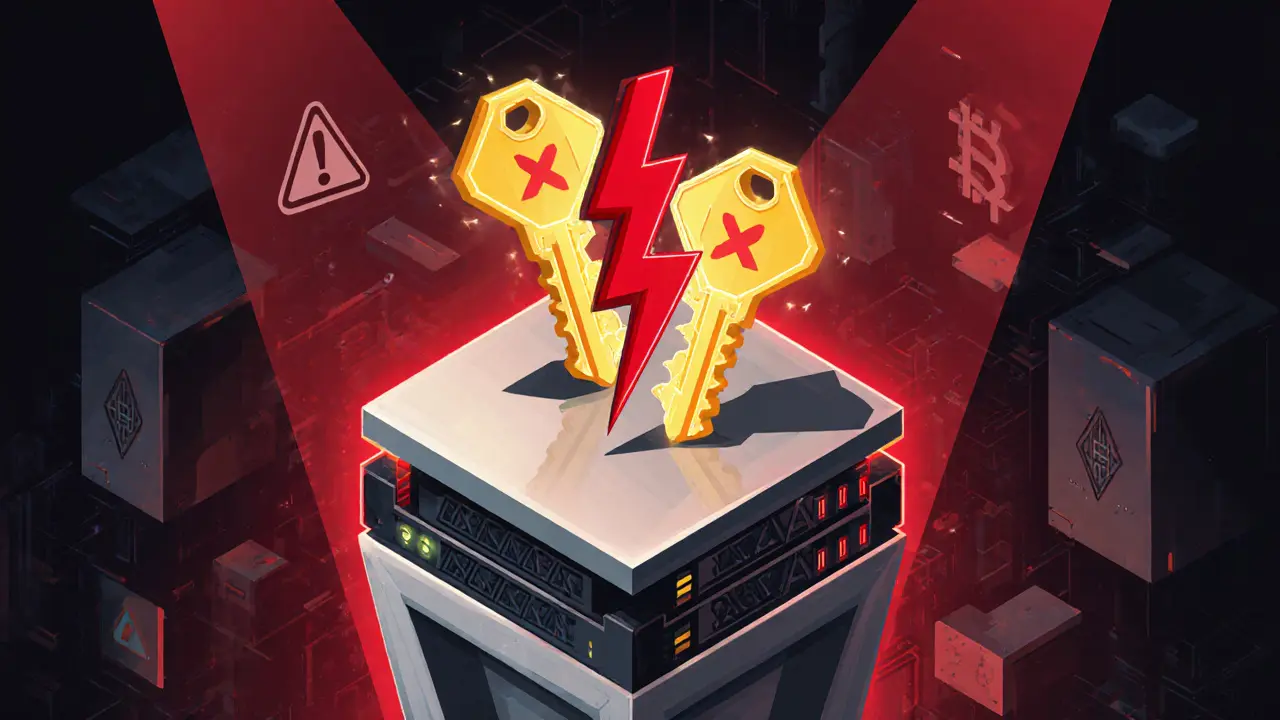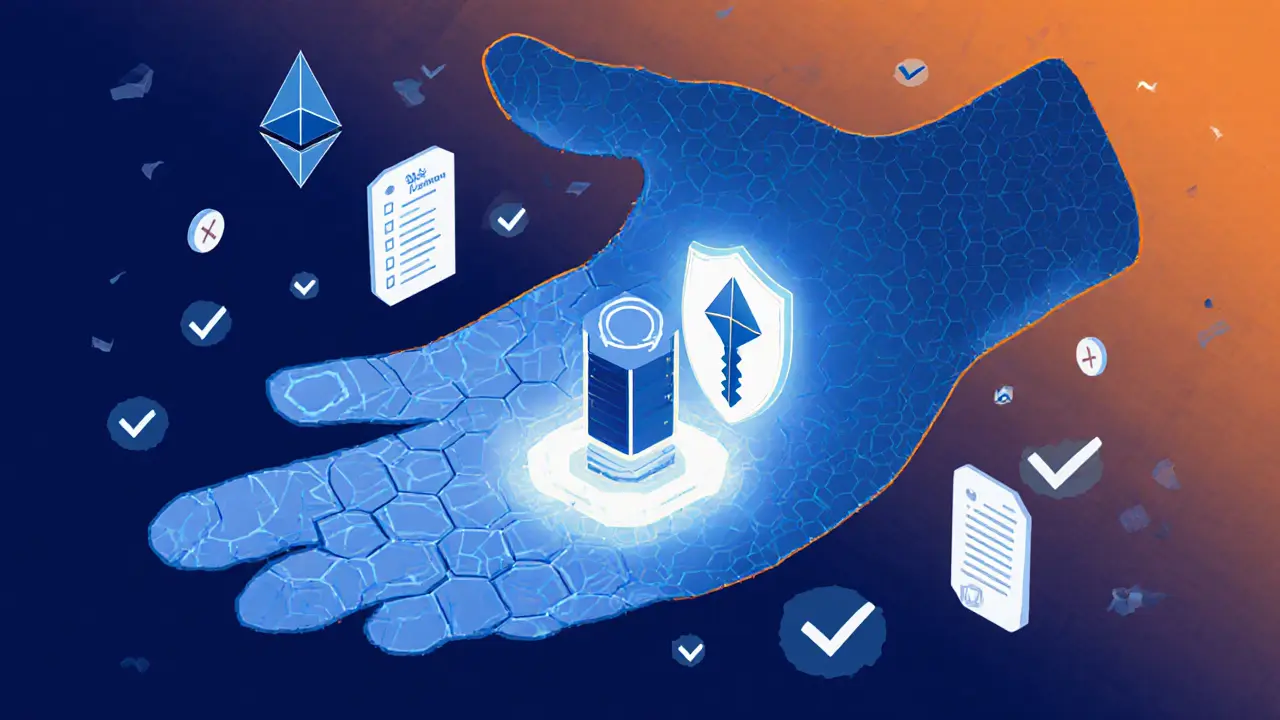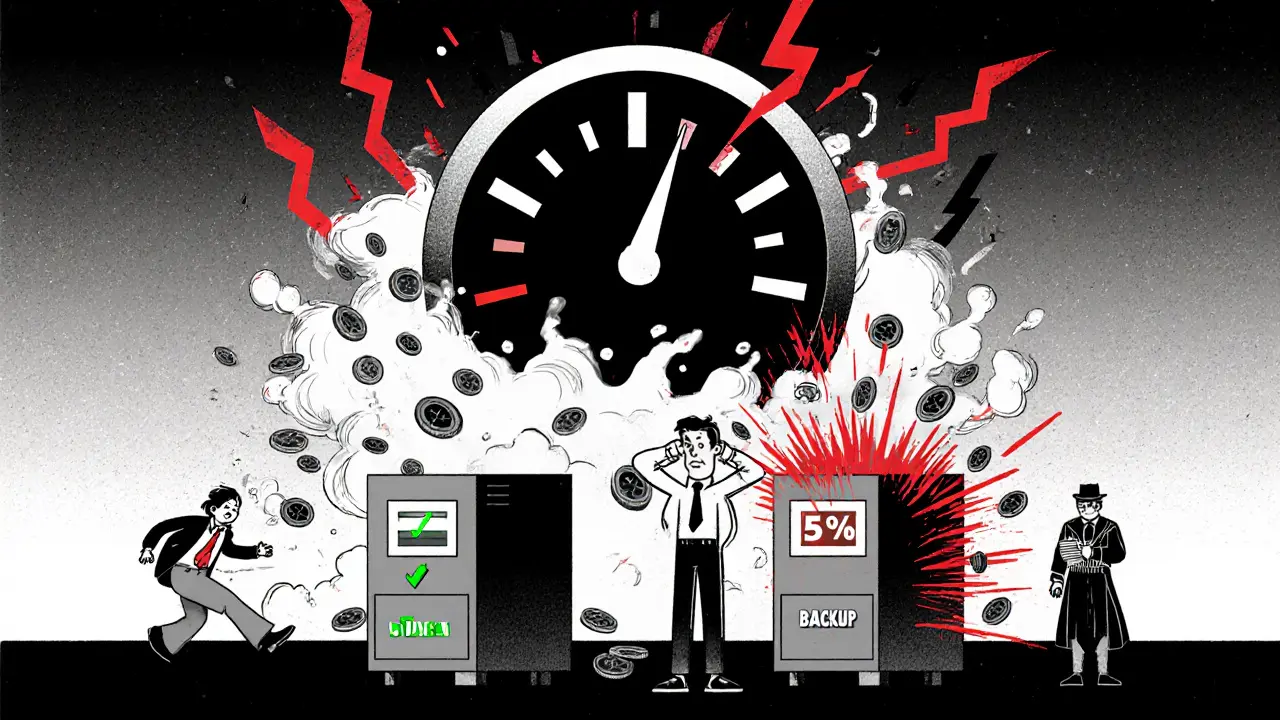How to Protect Against Slashing in Proof-of-Stake Blockchains
 Jan, 11 2025
Jan, 11 2025
Slashing Penalty Calculator
Slashing Penalty Calculator
Calculate potential financial losses from slashing incidents based on your staked amount and type of violation.
Enter your staked amount and select a violation type to see potential losses.
Slashing isn’t just a technical term-it’s a financial risk that can wipe out a significant portion of your staked crypto in seconds. If you’re running a validator on Ethereum, Polygon, or any other Proof-of-Stake (PoS) network, ignoring slashing protection is like driving without seatbelts. You might get lucky for months. But one mistake, one misconfigured backup, one duplicated key-and you lose part of your stake. For many, that’s tens of thousands of dollars gone overnight.
What Slashing Actually Means
Slashing is a built-in punishment system in PoS blockchains. It’s not a bug. It’s a feature. The network uses it to keep validators honest. When a validator acts maliciously or fails to perform, the protocol automatically penalizes them by burning a portion of their staked tokens. There are two main reasons slashing gets triggered:- Double signing: When the same validator signs two different blocks for the same slot. This is a serious offense-it means the validator is trying to create conflicting versions of history. Penalties can reach up to 5% of your staked balance.
- Validator downtime: When your validator is offline for too long during a consensus round. This is less severe, usually costing around 0.1% of your stake per incident. But if it happens repeatedly, it adds up.
The #1 Cause of Slashing: Duplicate Validator Keys
Most slashing incidents aren’t caused by hackers or malice. They’re caused by mistakes. The most common error? Running the same validator key on two different machines. People do this thinking they’re being smart-they set up a backup validator to avoid downtime. But if both validators are active at the same time, and they both sign blocks, the network sees it as double signing. Boom. Slashed. This isn’t hypothetical. In 2023, over 200 validators on Ethereum were slashed because they ran duplicate clients. Some lost over $10,000 each. All because they copied a key file from one server to another. The rule is simple: One validator key. One machine. No exceptions. Even if you’re using a cloud provider like AWS or a managed service, never duplicate your validator key. Never export it. Never back it up in a way that could be reactivated elsewhere.How CubeSigner and Web3 Signer Stop Slashing Before It Happens
The best slashing protection doesn’t just react-it prevents. Tools like CubeSigner and Web3 Signer are designed to make double signing impossible. CubeSigner works by storing your validator keys inside HSM-sealed Nitro enclaves on AWS. These aren’t regular servers. They’re tamper-proof hardware modules that physically prevent key extraction. Even if someone hacks your server, they can’t steal your key. And even if you try to sign two conflicting messages, the system checks its own history first. If a new signature would cause slashing, it just says no. Web3 Signer does something similar. It logs every signature your validator makes. Before it signs a new block, it checks: “Has this key signed something like this before?” If yes, it blocks it. It’s like having a personal bodyguard that only lets you do safe things. Both tools are open-source and trusted by institutional stakers. They don’t just reduce risk-they eliminate it. For anyone running more than one validator, these aren’t optional. They’re mandatory.
Why Backup Validators Are a Terrible Idea
You’ve probably heard: “Always have a backup.” That’s solid advice for servers, databases, websites. But it’s deadly for validators. Many users try to run a main validator and a backup validator simultaneously. They think: “If my main node crashes, the backup takes over.” But in PoS, there’s no graceful failover. If both are online at the same time, and both sign, you get slashed. The risk isn’t theoretical. In 2024, a major staking provider reported that 68% of all slashing events came from users who thought they were “being safe” by running backups. The real solution? Plan for downtime. Use reliable hardware. Monitor your node. If it goes down, fix it. Don’t turn on a second one. The 0.1% penalty for a few hours offline is far cheaper than losing 5% because you tried to be too clever.Security Practices That Actually Work
Beyond key management, there are other layers to protect yourself:- Use minimal access: Only give your validator server access to what it needs. No SSH from public IPs. No unnecessary services.
- Enable multi-factor authentication for all admin accounts.
- Log everything: Keep records of all configuration changes, key generations, and reboots.
- Audit your setup: Use tools like the Secure Staking Alliance’s EIP-3076 checklist to verify your validator meets industry standards.
- Get certified: Top staking providers follow ISO 27001:2022 and SOC 2 Type II. If you’re running a business, these aren’t buzzwords-they’re baseline requirements.
Slashing Is About Incentives, Not Just Tech
The real power of slashing isn’t in the code. It’s in the economics. It turns security into a market. Validators aren’t just “trusted” because they’re technical experts. They’re trusted because it’s cheaper to behave well than to cheat. The cost of trying to attack the network is higher than the reward. This is why PoS networks can be secure even without massive computational power. Unlike Bitcoin’s proof-of-work, where security relies on energy, PoS security relies on money. And money is easier to align with incentives. That’s why slashing is the backbone of modern blockchain security. It’s not about locking keys in vaults. It’s about making sure everyone’s self-interest lines up with the network’s survival.
What Happens If You Get Slashed?
Once you’re slashed, the penalty is immediate and irreversible. You can’t appeal it. You can’t reverse it. The tokens are burned. Your validator will be automatically deactivated. You’ll need to wait for the next exit queue to withdraw your remaining stake. Depending on network congestion, that could take days or weeks. And your reputation? Gone. If you’re running a staking service, clients will leave. If you’re an individual, you’ll lose trust in the community. The only way out? Learn. Fix your setup. Never repeat the mistake.Future of Slashing Protection
The ecosystem is evolving. More blockchains are adopting standardized anti-slashing protocols. Tools are becoming easier to use. Soon, you’ll be able to deploy a validator with one click-and have slashing protection built in. But until then, the responsibility is yours. No service, no cloud provider, no wallet will protect you if you copy your key to two servers. No automation can fix a bad decision. The most advanced slashing protection system in the world won’t help if you ignore the simplest rule: One key. One machine.Bottom Line
Protecting against slashing isn’t about buying expensive hardware or hiring experts. It’s about discipline.- Never duplicate your validator key.
- Never run backup validators while your main one is active.
- Use trusted tools like CubeSigner or Web3 Signer.
- Monitor your node. Check logs daily.
- Accept downtime over double signing.
What is slashing in Proof-of-Stake?
Slashing is a penalty in PoS blockchains where validators lose a portion of their staked tokens for breaking protocol rules. The two main triggers are double signing (signing two conflicting blocks) and prolonged downtime. Penalties range from 0.1% for downtime to up to 5% for double signing.
Can I avoid slashing by running a backup validator?
No. Running a backup validator while your main one is active creates a high risk of double signing. If both validators sign blocks at the same time, the network will slash both. The penalty is far worse than the cost of a few hours of downtime. Always run only one validator per key.
How do tools like CubeSigner prevent slashing?
CubeSigner stores validator keys in secure hardware enclaves (HSMs) that prevent key extraction. Before signing any message, it checks the key’s history to ensure the new signature won’t conflict with a previous one. If it would cause slashing, the system refuses to sign. This makes double signing technically impossible.
What’s the difference between double signing and downtime penalties?
Double signing is an intentional or accidental attempt to create conflicting blockchain history-it’s treated as malicious and carries a penalty of up to 5% of staked tokens. Downtime is when a validator misses its assigned slot to sign. It’s treated as negligence and usually costs only 0.1% per occurrence. Double signing is far more severe.
Who gets rewarded when a validator is slashed?
Any validator or participant who detects and submits proof of a slashing offense gets a reward. This reward comes from a portion of the slashed tokens. This creates a financial incentive for network participants to monitor for bad behavior, turning security into a collective effort.
Is slashing protection available for all blockchains?
Slashing exists on all major PoS networks, including Ethereum, Polygon, and Arbitrum. However, protection tools like CubeSigner and Web3 Signer are currently optimized for Ethereum and compatible chains. Other networks are adopting similar standards, but you must check each chain’s documentation for compatible tools.
Can I recover my slashed tokens?
No. Once tokens are slashed, they are permanently burned and removed from circulation. There is no appeal process, no refund, and no way to reverse it. Prevention is the only strategy.
Should I use a managed staking service to avoid slashing?
Yes-if you lack technical expertise or time to monitor your validator. Reputable managed services use enterprise-grade slashing protection, including hardware-backed key management and automated anti-slashing checks. They handle the complexity so you don’t have to. Just ensure they’re transparent about their security practices.
Anna Mitchell
October 30, 2025 AT 14:51Love this breakdown! I used to think backups were smart until I lost a few hundred bucks to a duplicate key. Now I just sleep better knowing my validator’s on one machine only. 🙌
Pranav Shimpi
November 1, 2025 AT 08:48u gotta be kidding me people still copy keys? i mean come on. i run 3 nodes and never even thought of backuping the key. just use prometheus + grafana to monitor uptime. if it dies, restart it. no second machine. no no no. also cube signer is overkill for solo stakers. web3 signer is enough. also dont use aws if you dont need it. digital ocean droplets are cheaper and just as secure if you lock down ssh. also dont forget to set up fail2ban. i lost 2 weeks of rewards once because i forgot to update the firewall. lol.
jummy santh
November 3, 2025 AT 05:04As someone from Nigeria who’s been staking since 2021, I can say this: slashing isn’t just a technical issue-it’s a cultural one. In many emerging crypto communities, people treat validator keys like passwords they can share with friends ‘for safety.’ We’ve had entire staking collectives slashed because one member ‘borrowed’ the key to test on a VPS. This post should be mandatory reading in every blockchain meetup in Lagos, Nairobi, and Jakarta. The economics of trust are universal, even if the mistakes aren’t.
Kirsten McCallum
November 3, 2025 AT 13:30One key. One machine. That’s it. No more, no less. If you need help, don’t run a validator. Simple.
Henry Gómez Lascarro
November 4, 2025 AT 01:24Everyone’s acting like this is some groundbreaking insight. Newsflash: this has been common knowledge since Ethereum 2.0 launched in 2020. The fact that people are still running duplicate keys proves how badly the crypto education system has failed. And don’t even get me started on CubeSigner-HSMs on AWS? That’s not ‘security,’ that’s corporate theater. Real security is running your own air-gapped machine in a Faraday cage with a deadbolt on the door. And you know what? Most of you don’t even know what a Faraday cage is. So stop pretending you’re doing ‘enterprise-grade staking.’ You’re just gambling with your life savings and calling it ‘decentralization.’
Will Barnwell
November 4, 2025 AT 09:13Why are we even talking about this? If you’re running a validator, you should already know this stuff. If you don’t, maybe don’t stake. Just pay a service. End of story. Also, Web3 Signer is fine but honestly, most of these tools are just wrappers around the same 5 lines of Go code. Nobody needs a whole platform for this.
Lawrence rajini
November 4, 2025 AT 11:12YES YES YES!!! 🙏 One key. One machine. That’s the mantra. I used to think I was being smart with backups… until my validator got slashed for 0.3% because I forgot one was still running. Now I use systemd timers to auto-check and reboot if it dies. No duplicates. No drama. Just clean, quiet, reliable staking. 🚀
Matt Zara
November 4, 2025 AT 12:15Hey everyone, just wanted to say this is one of the clearest posts I’ve seen on slashing. I’m a new staker and I was totally confused about backups. I thought having two validators was like having two smoke detectors. Turns out it’s more like having two guns pointed at your own foot. Thanks for the clarity. I’m switching to Web3 Signer tomorrow. Also, if you’re reading this and you’re unsure-ask. No shame in learning. We’ve all been there.
Jean Manel
November 5, 2025 AT 23:25Of course you’re going to get slashed if you’re dumb enough to duplicate keys. But let’s be real-most of you are just retail investors who don’t understand the underlying tech. You’re not ‘staking.’ You’re gambling with someone else’s infrastructure. And now you’re mad because the system punished you for being lazy. Welcome to crypto. The market doesn’t care if you ‘didn’t know.’
Paul Lyman
November 6, 2025 AT 21:19Big shoutout to everyone who’s been staking for years without getting slashed-you’re the real MVPs. I just started last month and I was terrified. This post saved me from making the backup mistake. I’m using Web3 Signer now and setting up alerts via Telegram. If my node goes down, I’ll fix it. No backup. No panic. Just discipline. You got this, newbies. 💪
Frech Patz
November 8, 2025 AT 21:13It is worth noting that the economic model of slashing is predicated upon the assumption of rational actors. However, empirical data from the Ethereum mainnet indicates that a non-trivial percentage of slashing events stem from misconfigurations among validators operating in low-resource environments, such as Raspberry Pi setups or underpowered cloud instances. This suggests that the incentive structure, while theoretically sound, may not be sufficiently robust to account for heterogeneous technical capabilities across the validator set. Further research into adaptive penalty functions may be warranted.
Derajanique Mckinney
November 9, 2025 AT 23:54cube signer? lol. why pay for that when you can just use a usb drive? also why are people still using aws? digital ocean is cheaper. and why do you need all these tools? just turn off your second machine. duh.
Rosanna Gulisano
November 10, 2025 AT 12:08Backup validators are stupid. Don’t do it. That’s it.
Sheetal Tolambe
November 10, 2025 AT 20:09This is so helpful! I was about to set up a backup validator because my last one crashed last week. Now I know better. I’ll just set up a better power backup and a monitoring alert. Thank you for writing this. I feel less scared now 😊
gurmukh bhambra
November 10, 2025 AT 23:02you know what’s really scary? what if the government or big tech secretly controls cube signer and web3 signer? what if they’re watching every signature? what if they’re waiting for you to stake big so they can trigger a fake slashing and take your coins? i mean… think about it. who built these tools? who owns the servers? are you sure you’re not handing over your keys to the NSA? 🤔
Sunny Kashyap
November 12, 2025 AT 14:59why do americans make everything so complicated? just use one machine. if it breaks, buy new one. no need for hsm or enclaves. in india we just use raspberry pi and sleep well. no stress. no tools. just simple.
james mason
November 14, 2025 AT 08:03Interesting. But honestly, if you’re not using institutional-grade infrastructure, you’re just a liability to the network. CubeSigner costs money. If you can’t afford it, you shouldn’t be validating. Period. This isn’t a hobby-it’s infrastructure. And you’re not ready.
Cory Munoz
November 14, 2025 AT 18:44Thank you for writing this. I’ve been running a validator for a year and never got slashed, but I didn’t fully understand why until now. The part about incentives clicking into place-like a domino effect of self-interest-was eye-opening. I’ll be sharing this with my local crypto study group. We’re all better off when we learn together.
Jasmine Neo
November 16, 2025 AT 06:56Let’s be brutally honest: 90% of these ‘slashing protection’ tools are just marketing fluff. The real issue? Most validators are run by people who can’t even set up a firewall. HSMs won’t fix ignorance. And the fact that the ecosystem rewards people for reporting others? That’s not security-that’s a snitch culture. And now we’re normalizing it. Great. Just great. Meanwhile, the real threat is centralized staking pools. But nobody talks about that because it’s more profitable to scapegoat the amateur staker.